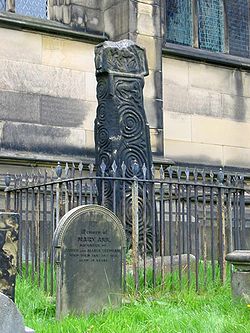- All Saints Church, Bakewell
-
All Saints Church 
9th century cross in the churchyard53°12′46″N 1°40′43″W / 53.2129°N 1.6786°WCoordinates: 53°12′46″N 1°40′43″W / 53.2129°N 1.6786°W Location Bakewell, Derbyshire Country  England
EnglandDenomination Church of England Administration Diocese Diocese of Derby All Saints Church, Bakewell is the parish church of Bakewell, Derbyshire. It is a Grade I listed building.
Contents
The first church
The church was founded in 920, during Saxon times and the churchyard has two 9th century Saxon crosses. During restoration work, in the 1840s, many carved fragments of Saxon stonework were found in and around the porch, as well as some ancient stone coffins.
The present church
The present church was started in the 12th century in Norman style however only the West front and part of the nave survive from that time. The remainder of the church was built between 1220 and 1240. The spire was added in 1340 but, in 1840, was completely rebuilt as it had become dangerous.
Misericords
All Saints' contains three early 15th century misericords, along with eighteen 19th century misericords in the choir stalls. Additionally, there is one 19th century misericord on a priests seat. The 19th century misericords date from 1881.
Relics and monuments
The church has some interesting relics of the Vernon and Manners families as well as a fine 14th century baptismal font. In the Vernon Chapel (off the South aisle) there are several magnificent tombs: Sir Thomas Wendesley (killed at the Battle of Shrewsbury in 1403; John Vernon of Haddon Hall, who died in 1477; and Sir George Vernon and his two wives.
Sir George, nicknamed 'King of the Peak',[citation needed] died in 1567, is famous as the father of Dorothy Vernon, who eloped with Sir John Manners, both of whom have a monument at the South end of the chapel. There is also a monument to their son, George Manners and his wife Grace. Outside the chapel is a much smaller alabaster monument to Sir John Foljambe and his wife.
Organ
The organ dates from 1810 when a "finger organ"[1] by J Lincoln was installed. This was rebuilt in 1851 by William Hill, and again in 1883 by Brindley & Foster. Further work by Jardine and Co in 1954 and George Sixsmith in 1989 have left the church with a 3 manual 42 speaking stop pipe organ. A specification of the organ can be found on the British Institute of Organ Studies National Pipe Organ Register at N00212.
Organists
- Thomas Barker Mellor ca.1883 - 1913?
- W.E. Cave 1913[2] - ????
- Glyn Davies 1982 - ????
The church today
Today, along with its regular religious services, the church is an important building in the town and the wider Peak District. It is used for, amongst other things, concerts by Bakewell Choral Society and the annual Commemoration service of Lady Manners School when they staff and pupils give thanks to Grace, Lady Manners for founding their school in 1636.
The church website has much more information about the ongoing life and worship of the parish, including forthcoming services and other events.
External links
References
Categories:- 920 establishments
- Church of England churches in Derbyshire
- Grade I listed buildings in Derbyshire
- 10th-century church buildings
Wikimedia Foundation. 2010.
